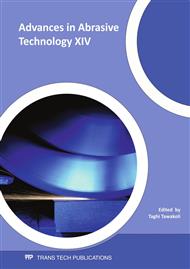p.406
p.412
p.418
p.424
p.430
p.436
p.442
p.451
p.457
Empirical Modeling and Analysis of Surface Roughness in Milling Process of Nickel-Based Super Alloy Nimonic 115 through Response Surface Methodology
Abstract:
Nimonic 115 is one of the essential Nickel-based super alloys is known as one of the most difficult-to-cut materials because of its unique properties. Appropriate selection of the machining parameters in milling of this material is so vital for improving the machining efficiency. This paper discusses the use of response surface methodology for modeling of surface roughness in milling of Nimonic 115 with coated carbide tools. The machining parameters used in this study, are cutting speed, feed rate, axial and radial depth of cut. Average Surface roughness was measured in different conditions and analysis of variance (ANOVA)was performed. Then, quadratic model for predicting the surface roughness is established. The results show that the most significant parameter which affects surface roughness is feed rate.
Info:
Periodical:
Pages:
430-435
Citation:
Online since:
August 2011
Authors:
Price:
Сopyright:
© 2011 Trans Tech Publications Ltd. All Rights Reserved
Share:
Citation:


